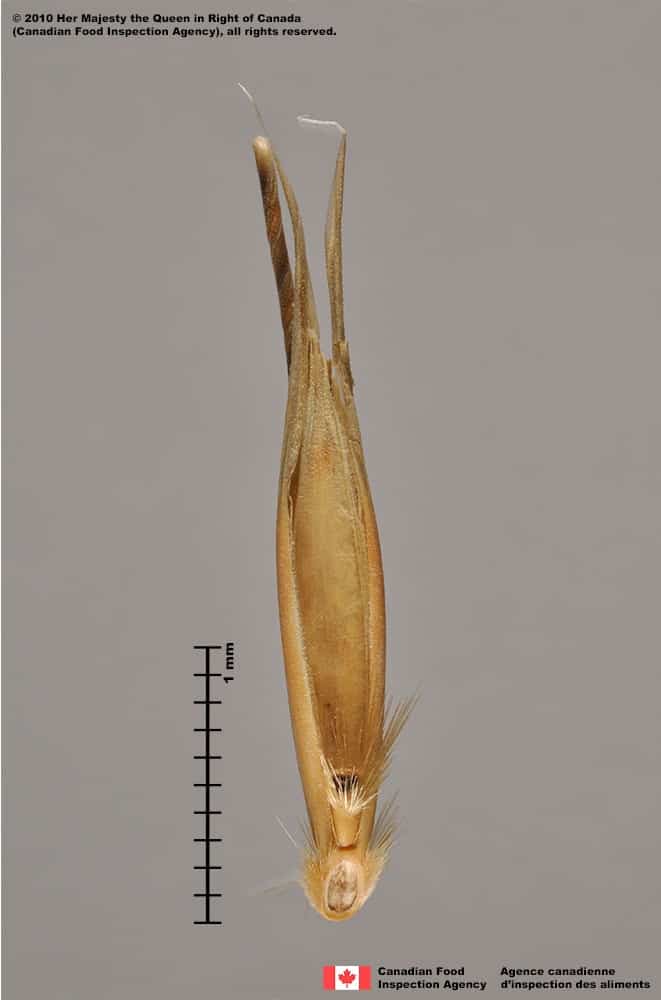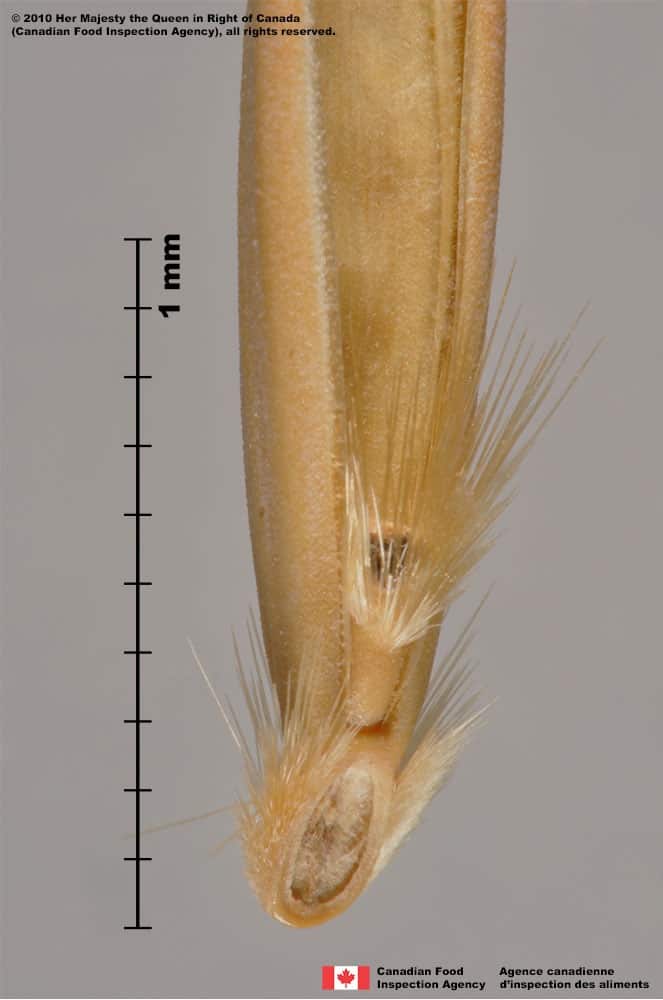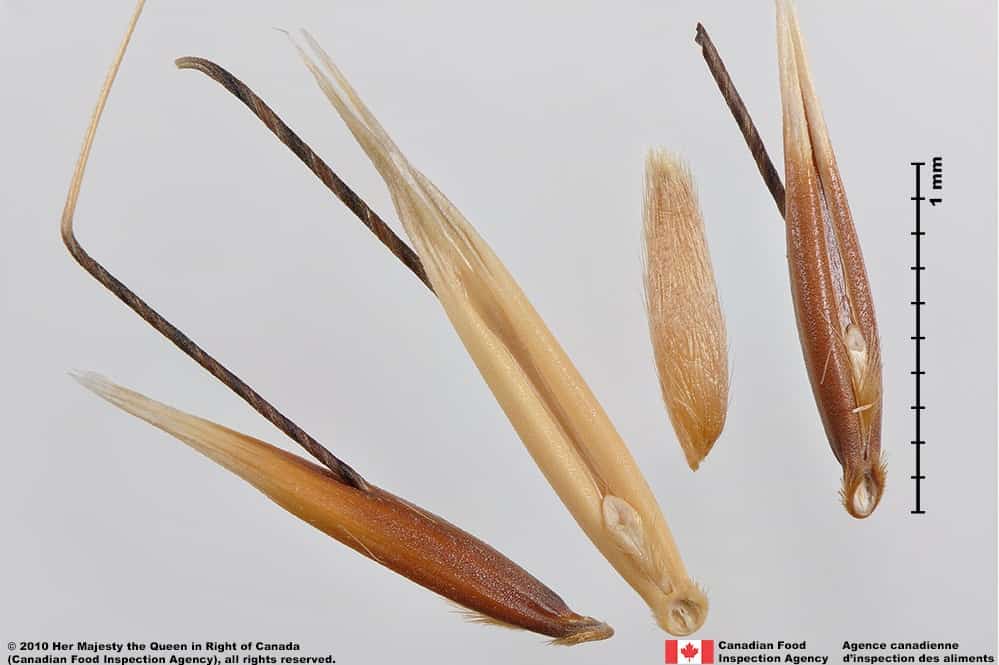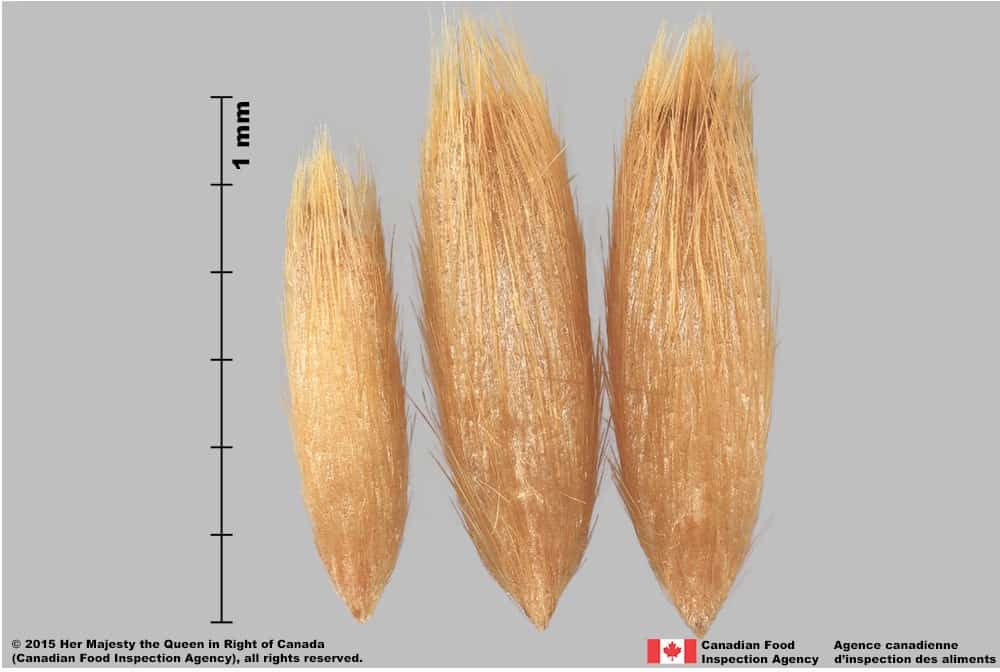Avena sterilis
Overview
Aperçu
Regulation :
Remarques Réglementation:
- CFIA Weed Seeds Order - Class 3: Secondary Noxious Weed Seeds
- USA Federal Noxious Weed List
- USA Federal Noxious Weed Seed List
Regulation Notes:
Distribution :
Répartition :
Native to southern Europe and the Mediterranean region; associated with the cultivation of oats (CABI 2021; USDA-ARS 2021). Widely introduced elsewhere and present on all continents except Antarctica (CABI 2021; USDA-ARS 2021). Occurs in the United States, in: California, Colorado, New Jersey, Ohio, Oregon and Pennsylvania (Kartesz 2015; USDA-NRCS 2021). Occurs sporadically in Ontario and previously reported from Quebec but currently excluded from the flora (Brouillet et al. 2010+).
Habitat and Crop Association :
Habitat et Cultures Associées :
Cultivated fields, roadsides and disturbed ground. A serious weed of arable crops, particularly cereals, with a life cycle that mirrors many annual crops. Often occurs on heavier soils, sometimes replacing the similar species Avena fatua in this soil type where the two co-occur (CABI 2021).
Economic Use, cultivation area, and Weed Association :
Utilisation économique, zone de culture et association de mauvaises herbes :
Duration of Life Cycle :
Durée du cycle vital:
Annual
Dispersal Unit Type :
Type d’unité de dispersion :
Florets
General Information
RENSEIGNEMENTS GÉNÉRAUX
Avena sterilis has been dispersed around the world as a contaminant in cereal grain and seed, as well as on agricultural equipment, straw, hay, livestock and wool. A crop mimic in Avena spp. (oat) crops, it produces seeds that are difficult to separate from grain (CABI 2021).
Individual plants can produce up to 200 seeds, although the average in a natural population has been reported as 13-21 seeds per plant. Seeds remain dormant for up to 5 years in the soil (CABI 2021).
Identification
Identification
-
Spikelet
Size
- Spikelet length: 24.0 – 50.0 mm (Barkworth et al. 2007)
Shape
- Spikelet wedge-shaped
Surface Texture
- Spikelet surface is smooth with 9-11 longitudinal nerves (Barkworth et al. 2007)
Colour
- Spikelets are dull straw yellow
Other Features
- 2-5 florets in a spikelet, florets shed generally as a pair, can be as a floret group (Barkworth et al. 2007)
- Glumes equal, 30-50 mm long, 9-11 nerved (CABI 2021)

Sterile oat (Avena sterilis) reddish florets and floret groups


-
Floret
Size
- First floret length*: 15.0 – 35.0 mm; width: 2.3 – 4.0 mm
- Second floret length*: 10.0 – 14.0; width: 2.0 – 2.5 mm
- Third and subsequent florets smaller than second floret
*Note: minimum and maximum of 10 florets in a normal range of this species using image measurement (ISMA 2020)
Shape
- Floret long oval shaped, pointed at end opposite the callus
Surface Texture
- Floret surface granular textured
Colour
- Florets generally shiny reddish brown with a straw yellow pointed end, but can be straw yellow
Other Features
Lemma awn
- A strongly bent and twisted awn is attached to the lemma of first and second florets 50.0 – 80.0 mm long (CABI 2021)
- Lemma of third and subsequent florets without awns
Callus and Rachilla
- Rachilla of first floret is a thick peg with a broken tip, generally densely hairy
- Rachilla of second and subsequent florets thin, flexible and dull straw yellow coloured
- Callus at the base of the first floret is egg-shaped, concave and surrounded by stiff, brown coloured hairs
- Callus of second and subsequent florets are a thick peg
Other Features
- Lemma end tapers into long, papery extensions
- The lemma surface can have sparse brown hairs, generally removed during processing
- Palea generally exposed in first and second florets
- The edges of the palea have numerous thin teeth

Sterile oat (Avena sterilis) reddish florets and floret groups







-
Caryopsis
Size
- Caryopsis length*: 9.0 – 10.0 mm; width: 2.0 – 2.5 mm
*Note: minimum and maximum of 5 caryopses in a normal range of this species using specimen measurement (ISMA 2020)
Shape
- Caryopsis is long oval or oblong shaped
Surface Texture
- Caryopsis is covered in stiff hairs
Colour
- Caryopsis is shiny straw yellow coloured
Other Features
- Has an indentation where the awn attaches to the lemma
-
Embryo
Size
- Embryo is rudimentary compared to the size of the caryopsis
Shape
- Oval or wedge-shaped, in a lateral position at one end of the caryopsis
Endosperm
- Endosperm is soft and opaque white coloured
Identification Tips
CONSEILS POUR L’IDENTIFICATION
Avena species have similar long oval shaped florets. A. sterilis florets can be distinguished from similar species by dark coloured, granular textured florets shed as a group of florets, with an egg-shaped shaped callus on the first floret, the rest with a cylindrical callus.

Sterile oat (Avena sterilis) reddish florets and floret groups







Additional Botany Information
AUTRES RENSEIGNEMENTS BOTANIQUES
Similar Species
ESPÈCES SEMBLABLES
Similar species are based on a study of seed morphology of various species, and those with similar dispersal units are identified. The study is limited by physical specimen and literature availability at the time of examination, and possibly impacted by the subjectivity of the authors based on their knowledge and experience. Providing similar species information for seed identification is to make users aware of similarities that could possibly result in misidentification.
A. fatua florets (length*: 7.6 – 18.8 mm; width: 1.4 – 2.4 mm) are generally shorter , callus of all florets oval or egg-shaped, and dispersed as single florets.
*Note: minimum and maximum of 17 florets in a normal range of this species using image measurement (ISMA 2020)
Click to select species
Cliquez pour sélectionner les espèces

Avena fatua
Comparison Window
Fenêtre de comparaison
MAIN SPECIES
ESPÈCES PRINCIPALES
Avena sterilis

Avena sterilis
Poaceae
Sterile oat (Avena sterilis) reddish florets and floret groups
MAIN SPECIES
ESPÈCES PRINCIPALES
Avena sterilis

Avena sterilis
Poaceae
Sterile oat (Avena sterilis) yellow florets and floret groups
MAIN SPECIES
ESPÈCES PRINCIPALES
Avena sterilis

Avena sterilis
Poaceae
Sterile oat (Avena sterilis) florets
MAIN SPECIES
ESPÈCES PRINCIPALES
Avena sterilis

Avena sterilis
Poaceae
Sterile oat (Avena sterilis) floret, palea view
MAIN SPECIES
ESPÈCES PRINCIPALES
Avena sterilis

Avena sterilis
Poaceae
Sterile oat (Avena sterilis) floret, lemma view
MAIN SPECIES
ESPÈCES PRINCIPALES
Avena sterilis

Avena sterilis
Poaceae
Sterile oat (Avena sterilis) floret, palea view
MAIN SPECIES
ESPÈCES PRINCIPALES
Avena sterilis

Avena sterilis
Poaceae
Sterile oat (Avena sterilis) floret, lemma view
SIMILAR SPECIES
ESPÈCES SEMBLABLES
Avena fatua

Avena fatua
Poaceae
Wild oat (Avena fatua) florets
SIMILAR SPECIES
ESPÈCES SEMBLABLES
Avena fatua

Avena fatua
Poaceae
Wild oat (Avena fatua) florets and caryopsis
SIMILAR SPECIES
ESPÈCES SEMBLABLES
Avena fatua

Avena fatua
Poaceae
Wild oat (Avena fatua) floret, palea view
SIMILAR SPECIES
ESPÈCES SEMBLABLES
Avena fatua

Avena fatua
Poaceae
Wild oat (Avena fatua) floret, lemma view
SIMILAR SPECIES
ESPÈCES SEMBLABLES
Avena fatua

Avena fatua
Poaceae
Wild oat (Avena fatua) floret, side view
SIMILAR SPECIES
ESPÈCES SEMBLABLES
Avena fatua

Avena fatua
Poaceae
Wild oat (Avena fatua) caryopses, embryo view
Need ID Help?
Besoin d’aide pour l’identification?
Reference(s)
Référence(s)
Barkworth, M. E., Capels, K. M., Long, S. and Piep, M. B. (eds.). 2007. Flora of North America Volume 24. Magnoliophyta: Commelinidae (in part): Poaceae, part 1. Oxford University Press, New York, New York.
Brouillet, L., Coursol, F., Meades, S. J., Favreau, M., Anions, M., Bélisle, P. and Desmet, P. 2010+. VASCAN, the database of vascular plants of Canada. http://data.canadensys.net/vascan/ Accessed May 30, 2016.
Centre for Agriculture and Bioscience International (CABI). 2021. Invasive Species Compendium, CAB International, Wallingford, UK. https://www.cabidigitallibrary.org/journal/cabicompendium Accessed March 2, 2021.
Kartesz, J.T. 2015. The Biota of North America Program (BONAP). North American Plant Atlas. Chapel Hill, N.C. http://www.bonap.net/napa Accessed March 2, 2021.
Flora of North America (FNA) Editorial Committee, eds. 1993+. Flora of North America North of Mexico [Online]. 22+ vols. New York and Oxford. http://beta.floranorthamerica.org. Accessed December 29, 2022.
Global Biodiversity Information Facility (GBIF) Secretariat. 2022. https://doi.org/10.15468/39omei Accessed via https://www.gbif.org/species/2705286 Accessed December 29, 2022.
Government of Canada (GC). 2016. Canadian Weed Seeds Order. https://laws-lois.justice.gc.ca/eng/regulations/SOR-2016-93/page-2.html (English) https://laws-lois.justice.gc.ca/fra/reglements/DORS-2016-93/page-2.html (French)
International Seed Morphology Association (ISMA). 2020. Method for Seed Size Measurement. Version 1.0. ISMA Publication Guide. https://www.idseed.org/authors/details/method_for_seed_size_measurement.html
U.S. Department of Agriculture-Agricultural Research Services (USDA-ARS). 2021. Germplasm Resources Information Network (GRIN), https://npgsweb.ars-grin.gov/gringlobal/taxon/taxonomysimple.aspx Accessed March 2, 2021.
U.S. Department of Agriculture-Natural Resources Conservation Service (USDA-NRCS). 2021. The PLANTS Database. National Plant Data Team, Greensboro, NC USA. http://plants.usda.gov Accessed March 2, 2021.




